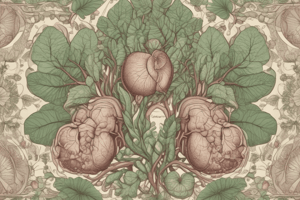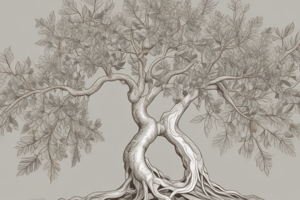Podcast
Questions and Answers
Which of the following statements is NOT true regarding vascular tissue in plants?
Which of the following statements is NOT true regarding vascular tissue in plants?
- In roots, vascular tissue is found in the central vascular cylinder.
- In leaves, vascular tissue is located within the leaf veins.
- In stems, vascular tissue is organized into vascular bundles.
- Phloem cells, which are hollow and nonliving, form a continuous pipeline for sugar transport. (correct)
- Xylem cells, which are hollow and nonliving, create a continuous pipeline for water and mineral transport.
Which of the following statements about leaf structure is incorrect?
Which of the following statements about leaf structure is incorrect?
- Guard cells regulate gas exchange by controlling the opening and closing of stomata.
- The photosynthetic mesophyll in eudicots consists of an upper spongy layer and a lower palisade layer. (correct)
- Vascular tissue in eudicots exhibits a net-like pattern, while in monocots, it follows a parallel arrangement.
- The epidermis is coated with a waxy cuticle to minimize water loss.
- Gas exchange is facilitated by stomata, small openings on the leaf surface.
What primary role does the mesophyll layer serve in leaves?
What primary role does the mesophyll layer serve in leaves?
- Absorbing the majority of water required for photosynthesis.
- Preventing the plant from drying out.
- Serving as the primary site for photosynthesis. (correct)
- Anchoring the plant to the soil.
Considering the conflicting roles of leaf stomata in allowing carbon dioxide uptake and preventing water loss, which adaptation is most reasonable?
Considering the conflicting roles of leaf stomata in allowing carbon dioxide uptake and preventing water loss, which adaptation is most reasonable?
In what order are the layers of a typical leaf arranged, starting from the upper surface and progressing to the lower surface?
In what order are the layers of a typical leaf arranged, starting from the upper surface and progressing to the lower surface?
Damage to which leaf tissue layer would most directly impair the ability of the leaf to exchange gases effectively?
Damage to which leaf tissue layer would most directly impair the ability of the leaf to exchange gases effectively?
In large woody plants, what are the primary components of wood and bark respectively?
In large woody plants, what are the primary components of wood and bark respectively?
In older woody plants, which tissue replaces the epidermis of the stem?
In older woody plants, which tissue replaces the epidermis of the stem?
A fifteen-foot tree has barbed wire stapled to it at a height of five feet. Years later, the tree is thirty feet tall. Approximately where is the fence now located?
A fifteen-foot tree has barbed wire stapled to it at a height of five feet. Years later, the tree is thirty feet tall. Approximately where is the fence now located?
If a plant stem has the terminal bud removed, browsing deer would consume it. How would this affect the plant's growth?
If a plant stem has the terminal bud removed, browsing deer would consume it. How would this affect the plant's growth?
What structure can an axillary bud potentially develop into?
What structure can an axillary bud potentially develop into?
If a plant stem has seven bud scale scars, approximately how old is the plant?
If a plant stem has seven bud scale scars, approximately how old is the plant?
Which statement is NOT true concerning woody stems?
Which statement is NOT true concerning woody stems?
Which of these represents a stem adaptation, as opposed to a root adaptation?
Which of these represents a stem adaptation, as opposed to a root adaptation?
Which of the following best describes the arrangement and function of vascular bundles in a herbaceous eudicot stem?
Which of the following best describes the arrangement and function of vascular bundles in a herbaceous eudicot stem?
Flashcards
Phloem vs Xylem
Phloem vs Xylem
Phloem cells are living tissue that transports sugars. Xylem cells are nonliving tissue that transport water and minerals.
Stomata
Stomata
tiny openings in the leaf surface that allow gas exchange
Mesophyll Layers
Mesophyll Layers
Photosynthetic mesophyll in eudicots is divided into an upper palisade layer and a lower spongy layer.
Leaf Layers (Top to Bottom)
Leaf Layers (Top to Bottom)
Signup and view all the flashcards
Spongy Mesophyll Function
Spongy Mesophyll Function
Signup and view all the flashcards
Wood vs Bark Composition
Wood vs Bark Composition
Signup and view all the flashcards
Periderm Function
Periderm Function
Signup and view all the flashcards
Terminal Bud Role
Terminal Bud Role
Signup and view all the flashcards
Bud Scale Scars
Bud Scale Scars
Signup and view all the flashcards
Axillary Bud
Axillary Bud
Signup and view all the flashcards
Secondary Pholem
Secondary Pholem
Signup and view all the flashcards
Herbaceous Eudicot Stems
Herbaceous Eudicot Stems
Signup and view all the flashcards
Stolon, Rhizomes, Tubers, Corms
Stolon, Rhizomes, Tubers, Corms
Signup and view all the flashcards
Monocot
Monocot
Signup and view all the flashcards
Perennial
Perennial
Signup and view all the flashcards
Study Notes
- The cortex in the center of a dicot stem or monocot root consists of ground tissue.
- Farmers wanting crops with access to groundwater several meters below ground should use a taproot system.
- The layers of cells protecting the root apical meristem are the root cap.
- Pulling out bushes without clearing enough soil around the root system, causes the lateral roots and root hairs to be torn off.
- Epidermis tissue produces root hairs within the zone of maturation.
- Wood in large woody plants is xylem, and bark is phloem and cork.
- Periderm replaces the epidermis in older woody plants.
- The terminal bud would decrease the potential for an increase in plant height if nibbled off.
- Approximately five feet up is where a fifteen-foot tree growing in a fence row will grow since a tree grows longer at the tips of its stem, branches, and roots.
- An axillary bud may produce a lateral branch or a flower.
- Seven bud scale scars on a plant indicate it is seven years old.
- Secondary phloem accumulates to form the wood is not a true statement about woody stems.
- Vascular bundles arranged in a ring which store water and the products of photosynthesis best describe a herbaceous eudicot stem.
- Stolon, rhizomes, tubers, and corms are all stem adaptations instead of root adaptations.
- Phloem cells are hollow and nonliving, and form a continuous pipeline that transports sugars is not true about vascular tissue in plants.
- The photosynthetic mesophyll is made up of an upper spongy layer and a lower palisade layer in eudicots is not a correct statement about leaves.
- The correct order of layers of a leaf from upper to lower surface is cuticle - epidermis - palisade mesophyll - spongy mesophyll - epidermis - cuticle.
- A spongy mesophyll destroyed by an insect would decrease the ability of gas exchange within a leaf.
- Most of the photosynthesis occurs in the mesophyll layer of leaves.
- A submerged-water plant would have no stoma because leaf stoma have the conflicting functions of allowing gaseous carbon dioxide into the leaf, yet preserving the plant's supply of water.
- If you need to identify a plant, but it is winter; cutting the stem and observing scattered vascular bundles indicates it is a monocot.
- It is best to look near the root tip of a plant for a microscope slide of mitosis.
- All of the choices anchor the plant, store the products of photosynthesis, and produce hormones that stimulate stem growth are plant root functions.
- The plant will contain one cotyledon, have parallel veins in the leaves, and the flowers will be in multiples of threes are necessary to classify a plant as a monocot.
- A plant that survives multiple growing seasons due to flower-inducing genes being blocked is described as perennial.
- Protoderm, ground meristem, and procambrium are meristems that arise from the apical meristem, EXCEPT epidermis.
- The epidermis of a plant is not impervious to gas exchange.
- Ground tissue makes up the majority of the interior of the plant.
- The epidermis is the outer protective covering of a plant.
- Vascular tissue transports water and nutrients within a plant.
- collenchyma is not a specialized epidermal cell.
- Parenchyma most closely corresponds to the "typical" unspecialized plant cell.
- Xylem and pholem tissue types are not found only in the zone of cell division of the root tip.
- The endodermis forms a boundary between the cortex and inner vascular cylinder of the root and contains impermeable lignin and suberin.
- Rhizome is an underground horizontal stem.
- The apical meristem arises from the meristems, except for the epidermis.
- Protoderm-vascular tissue is a mismatched meristem and tissue type.
- Collenchyma is composed of cells with primary walls thickened at the corners that provide support for immature parts of the cell body.
- Xylem is composed of hollow nonliving tracheids and vessel elements that transport water and nutrient minerals from the roots to the leaves.
- Phloem contains sieve-tube members and companion cells, and transports organic nutrients made in the leaves.
- Sieve-tube members are vascular tissue cells that are alive but lack a nucleus.
- Phloem transports organic nutrients and sugars from the leaves to the roots.
- Epidermal tissue - parenchyma cells is the incorrect pairing of tissue type with cell type.
- You'd want to tap into pholem tissue layer to extract syrup in a maple tree.
- Damage to the parenchyma cells can lead to a decrease in the plant's ability to run photosynthesis or store the sugars produced from photosynthesis.
- While cell walls, plasmodesmata, and plastids are present, Centrioles are not present during mitosis in plant cells.
Studying That Suits You
Use AI to generate personalized quizzes and flashcards to suit your learning preferences.




